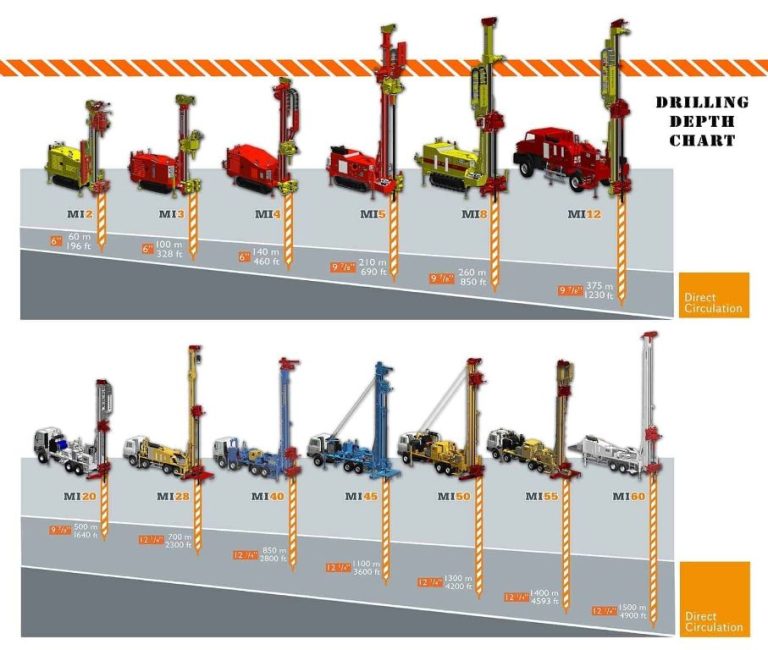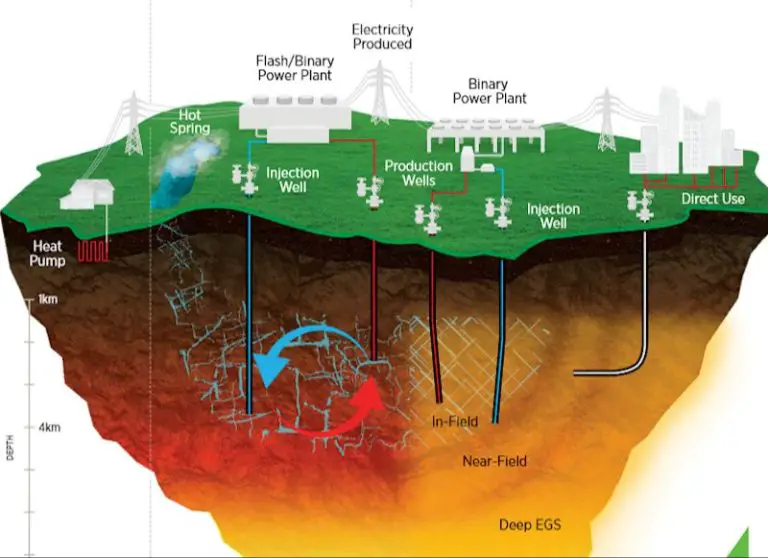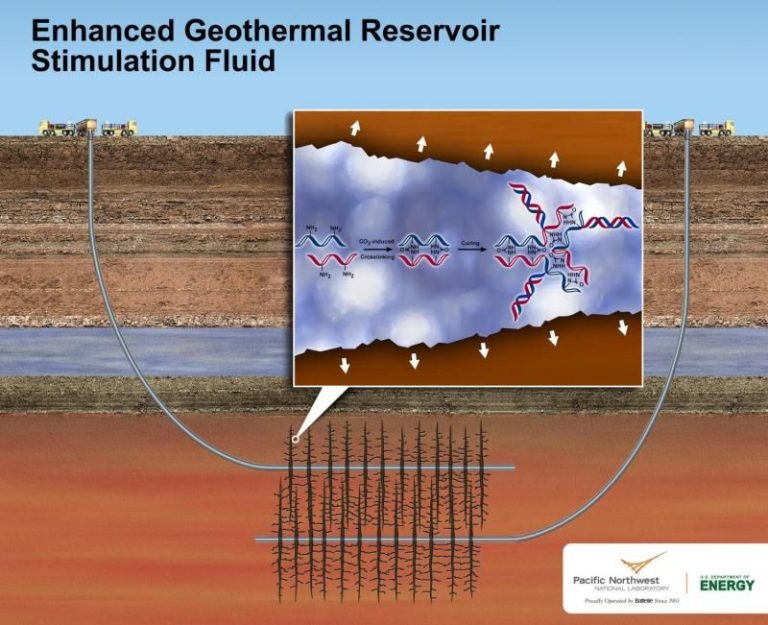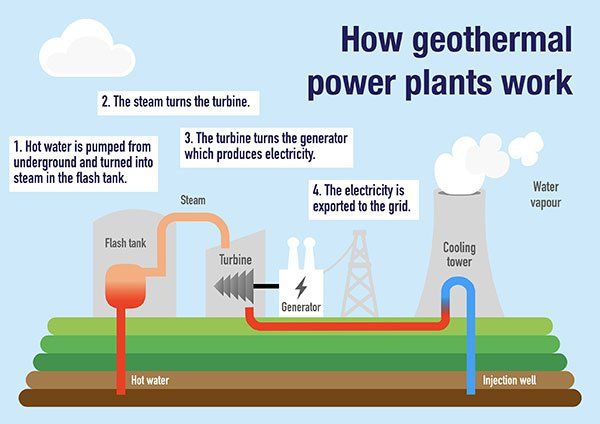Is Geothermal Extracted Or Harnessed?
Geothermal energy refers to the heat energy that is stored underneath the Earth’s surface. The word “geothermal” comes from the Greek words geo (earth) and therme (heat). Geothermal energy is considered a renewable energy source because the heat emanating from the interior of the Earth is constantly being replenished. The core of the planet is over 4,000 miles deep and temperatures can reach over 9,000 degrees Fahrenheit. This immense heat from the Earth’s core escapes outward and heats underground rock and water. Humans have devised technologies to capture and utilize this geothermal energy in a variety of applications.
This content will provide an overview of how geothermal energy is both extracted directly from the Earth’s crust and harnessed from underground reservoirs and hot water sources. It will examine the pros and cons, environmental impact, various use cases, and the future global outlook for geothermal energy.
Geothermal Energy 101
Geothermal energy utilizes heat from the Earth’s core to generate electricity and provide heating and cooling. The Earth’s core remains at a nearly constant temperature between 4,000 and 12,000 degrees Fahrenheit due to residual heat from planetary formation as well as heat produced by the decay of radioactive elements (How geothermal electricity generation works). This heat radiates outwards and heats subsurface rock and water. In some areas, thermal energy moves close enough to the surface to heat ground water and rock, sometimes up to 700 degrees Fahrenheit. This naturally heated water is tapped at geothermal reservoirs located up to two miles below the Earth’s surface to drive steam turbines and generate electricity (UCSUSA). The steam rotates the turbine which activates a generator, thereby producing electricity. Geothermal power plants are built over these geothermal reservoirs to harness the steam and hot water.
Geothermal Extraction
Geothermal energy is extracted from underground reservoirs located near tectonic plate boundaries or other areas of high volcanic and seismic activity. Wells are drilled into these reservoirs to pump hot water or steam to the surface. The depth of these wells can range from a few hundred feet to several miles deep.
There are three main types of geothermal energy extraction:
- Dry steam plants use steam from a geothermal reservoir to directly drive turbine generators. This is the oldest and simplest extraction method.
- Flash plants take high pressure hot water above 360°F from deep inside the earth and convert it to steam to drive turbines. This is the most common geothermal plant today.
- Binary cycle plants transfer the heat from geothermal hot water to another liquid. The secondary liquid boils at a lower temperature than water, so it can drive the turbines 1.
The geothermal extraction process involves drilling production wells, injecting working fluids, producing steam or hot water, routing the fluid, generating electricity via turbines, condensing the steam, and re-injecting fluid into injection wells. This full loop allows optimal usage of the geothermal reservoir 2.
Geothermal Harnessing
After geothermal energy is extracted from deep underground reservoirs, there are a few main methods to harness it to generate electricity or heat buildings:
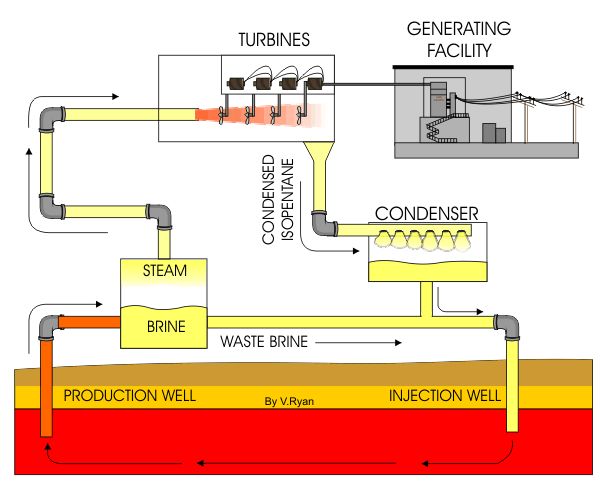
Flash steam plants use geothermal reservoirs of water with temperatures over 360°F. When this very hot water is released from the pressurized depths of the reservoir, it flashes instantly to steam to spin a turbine generator. Flash steam plants are the oldest and simplest geothermal power plants.
Binary cycle plants transfer the heat from geothermal water to another liquid with a much lower boiling point, usually a hydrocarbon like isobutane. The vapor from the secondary liquid then spins the turbine generator. Binary cycle plants allow lower temperature reservoirs to be used.
Direct use involves harnessing hot water directly from the subsurface reservoirs via wells or pumps. The hot water can be used for heating buildings, greenhouses, fish farms, and industrial processes without converting it to electricity first. Direct use applications are common worldwide.
Geothermal heat pumps use stable ground or water temperatures near the Earth’s surface to control building temperatures above ground. These systems do not actually generate electricity but help harness geothermal energy for heating and cooling.
In summary, geothermal energy harnessed after extraction can generate electricity through steam or binary cycles, provide direct heating, or help regulate building temperatures via geothermal heat pumps.
Pros and Cons
Geothermal energy has several advantages and disadvantages worth considering. On the pros side, geothermal energy is a renewable and sustainable energy source that does not require any fuel input after initial setup costs. It has a small land footprint compared to other renewables and provides a reliable, consistent power output unaffected by weather fluctuations. Geothermal energy can also provide heating and cooling services in addition to electricity generation. The resource potential for geothermal energy is huge, with an estimated 42 million megawatts available globally.
However, there are also some downsides. High upfront costs make geothermal energy expensive to install and develop initially. It is location specific, with availability limited by geological factors, and can lead to surface instability or induced seismicity in some cases. There are also environmental concerns related to air and water pollution from geothermal plants, and greenhouse gas emissions do occur although at lower levels than fossil fuel plants. Overall, geothermal energy has advantages as a clean, renewable resource but disadvantages related to costs, location constraints, and potential environmental impacts.
Sources:
https://www.twi-global.com/technical-knowledge/faqs/geothermal-energy/pros-and-cons
https://www.energysage.com/about-clean-energy/geothermal/pros-cons-geothermal-energy/
Environmental Impact
Geothermal energy is considered a clean and renewable energy source, but it does have some environmental impacts that need to be managed. According to the Union of Concerned Scientists, the main environmental concerns related to geothermal power plants are emissions, water consumption, and land use.
Geothermal plants emit some sulfur dioxide and carbon dioxide emissions, but at much lower levels than fossil fuel plants. The hot water brought up from underground reservoirs also contains dissolved minerals and gases that can impact air and water quality if not properly treated and disposed of. Proper reservoir management and emission controls are important to minimize air pollution.
Geothermal plants use water pumped from underground to extract heat – while the water is recycled, some is lost through evaporation. This can deplete water resources, especially in arid regions. Water consumption needs to be monitored and minimized. The used geothermal water also needs to be properly disposed of as it contains high mineral content.
Finally, geothermal plants require land clearing and access roads for drilling rigs. This directly impacts habitat loss and landscape disturbance. Care needs to be taken to minimize land footprint and restore sites after use according to US Energy Information Administration.
Geothermal Use Cases
Geothermal energy has many applications depending on the temperature and depths of the geothermal reservoirs. According to the National Renewable Energy Laboratory (https://www.nrel.gov/research/re-geothermal.html), geothermal energy can be used directly for heating and cooling buildings, greenhouse heating, aquaculture, and industrial uses.
Some key use cases for geothermal energy include:
- Electricity generation – Geothermal power plants use high temperature reservoirs (>300°F) to produce electricity.
- Space heating and cooling – Geothermal heat pumps use shallow ground temperatures for heating and cooling buildings. This can reduce energy costs by up to 70%.
- Industrial processes – Food dehydration, gold mining, and milk pasteurization utilize geothermal heat directly in their industrial processes.
- Agriculture – Geothermal heating prolongs growing seasons in greenhouses and aids in aquaculture operations.
According to Plug and Play Tech Center (https://www.plugandplaytechcenter.com/resources/harnessing-earths-heat-applications-of-geothermal-energy/), geothermal energy can replace up to 80% of electricity needs and lower heating bills by 25-50% in some regions with substantial geothermal resources.
Global Use
Geothermal energy is used in over 27 countries around the world for electricity generation and direct heating purposes. Some of the top countries utilizing geothermal include:
Iceland (Pop. 400,000) – Geothermal supplies over 65% of Iceland’s primary energy use. It generates close to 30% of Iceland’s electricity. Iceland has taken advantage of its unique geological location along tectonic plate boundaries to develop extensive geothermal resources.
United States (Pop. 330 million) – The United States generates the second highest amount of geothermal electricity after Indonesia. In 2021, geothermal accounted for 0.4% of total U.S. utility-scale electricity generation. Geothermal electricity generation has gradually increased over the decades as new plants come online, reaching 17 billion kWh in 2020.
Indonesia (Pop. 280 million) – Indonesia generates over 11,000 MW of geothermal power capacity, the largest in the world. Geothermal supplies about 5% of Indonesia’s electricity. Indonesia has 40% of the world’s total geothermal resources, though much of it remains untapped.
Global geothermal power capacity grew at an average annual rate of 5% between 2010-2020. With increasing policy support and technology improvements, the geothermal market is expected to accelerate in the coming years. However, it still accounts for only a fraction of renewable energy capacity globally.
Future Outlook
Geothermal energy is projected to play an increasingly important role in the global renewable energy mix going forward. According to research from MIT, geothermal power capacity could grow over 26-fold worldwide by 2050 (The Future of Geothermal Energy). The International Renewable Energy Agency also predicts rapid growth, with geothermal generation tripling or quadrupling by 2030.
Several factors point to a bright future for geothermal energy. First, geothermal power is not intermittent like solar or wind, providing consistent baseload power. This makes geothermal an ideal complement to increase grid stability as more renewables come online (Can Geothermal Play a Key Role in the Energy Transition?). Second, new technologies like enhanced geothermal systems (EGS) can unlock geothermal resources previously unreachable, vastly expanding geothermal potential globally.
However, barriers like upfront costs and policy support remain. More investment and supportive policies will be needed for geothermal to scale up significantly. If these challenges are addressed, geothermal could provide over 3% of global electricity by 2030 and much higher portions in countries with abundant geothermal resources like Iceland and Kenya (Full Steam Ahead: Unearthing the Power of Geothermal). Overall, geothermal looks poised to grow sustainably for decades to come.
Conclusion
In summary, geothermal energy refers to the heat within the Earth that can be harnessed to generate clean electricity and provide heating and cooling. While some geothermal resources are accessed by drilling into hot rock and extracting the heated fluid, most geothermal energy is harnessed using geothermal heat pumps that utilize shallow ground or surface water temperatures.
Geothermal heat pumps do not actually extract geothermal energy, but simply move existing heat between the shallow ground and buildings for heating and cooling purposes. The key distinction is that geothermal energy is primarily harnessed, not extracted, in most applications. Only high-temperature geothermal resources located deep underground are actually extracted.
Overall, geothermal energy is an abundant and renewable resource that can provide clean, reliable energy around the clock. Most geothermal applications harness heat already present at shallow depths, minimizing environmental impacts. With further development, geothermal has the potential to play an even greater role in the global energy mix.

